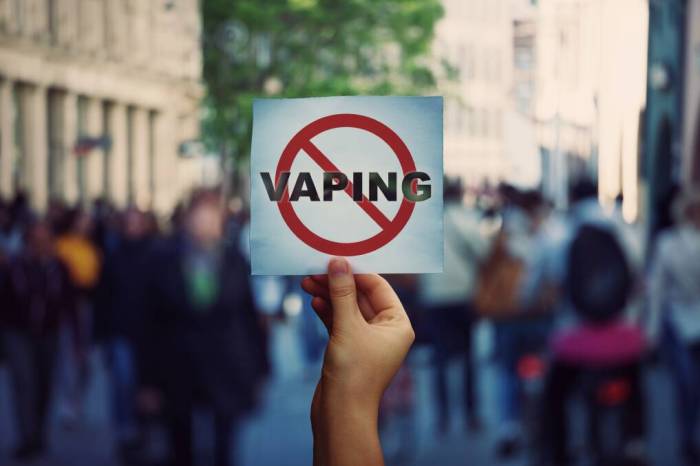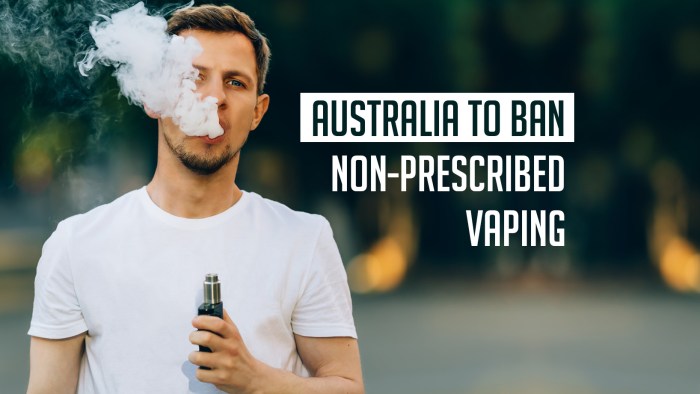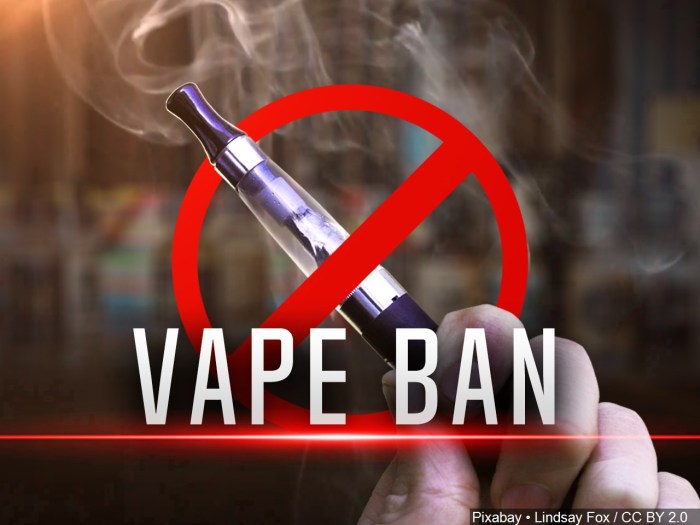Vape Ban Australia: Navigating the intricate web of vaping regulations, health concerns, and socio-economic implications. Delve into the heart of the debate, exploring the potential consequences and alternative approaches to vaping control.
The Australian government has taken a proactive stance on vaping, implementing strict regulations and considering a potential ban. However, the issue remains shrouded in controversy, with proponents citing health risks and opponents emphasizing harm reduction benefits.
Introduction

Vaping, also known as e-cigarette use, has become increasingly prevalent in Australia in recent years. Vaping devices heat a liquid solution, typically containing nicotine, flavorings, and other chemicals, to produce an aerosol that is inhaled by the user.
Currently, vaping regulations in Australia are complex and vary across different states and territories. While some jurisdictions have implemented restrictions on the sale and use of vaping products, others have adopted a more permissive approach.
Prevalence of Vaping in Australia
According to the Australian Bureau of Statistics, in 2021, an estimated 2.3% of Australians aged 18 years and over used e-cigarettes in the past 12 months. This figure represents a significant increase from 0.7% in 2016.
The prevalence of vaping is particularly high among young people. In 2021, an estimated 7.1% of Australians aged 18-24 years used e-cigarettes in the past 12 months.
Current Status of Vaping Regulations in Australia
The regulation of vaping products in Australia is primarily governed by the Therapeutic Goods Administration (TGA). The TGA classifies vaping products as therapeutic goods, which means they must meet certain safety and quality standards before being sold in Australia.
In 2021, the TGA introduced new regulations that require all vaping products to be approved by the TGA before they can be sold in Australia. These regulations also prohibit the sale of vaping products to people under the age of 18.
As the Vape Ban Australia debate continues to heat up, let’s take a break and explore the captivating cast of Red Sparrow . This 2018 spy thriller features a stellar lineup including Jennifer Lawrence, Joel Edgerton, and Matthias Schoenaerts. Back to Vape Ban Australia, the controversy surrounding the ban has sparked discussions on public health, personal freedoms, and the role of government in regulating such products.
Despite these regulations, the sale and use of vaping products remain relatively unrestricted in some states and territories. For example, in New South Wales, vaping products can be sold in retail stores and online without a prescription.
Health Impacts of Vaping
Vaping has become increasingly popular in recent years, particularly among young people. While it is often marketed as a safer alternative to smoking traditional cigarettes, there is growing evidence that vaping can have significant health risks.
One of the most concerning aspects of vaping is the potential for respiratory problems. E-cigarettes contain nicotine, which is a known respiratory irritant. Inhaling nicotine can cause inflammation and damage to the lungs, leading to symptoms such as coughing, wheezing, and shortness of breath.
In some cases, vaping has been linked to more serious respiratory conditions, such as popcorn lung (bronchiolitis obliterans).
Cardiovascular Health
Vaping can also have negative effects on cardiovascular health. Nicotine is a vasoconstrictor, which means it narrows blood vessels and increases blood pressure. This can put strain on the heart and increase the risk of heart disease, stroke, and other cardiovascular events.
E-cigarettes as a Smoking Cessation Aid
While some people have used e-cigarettes as a way to quit smoking traditional cigarettes, the evidence for their effectiveness as a smoking cessation aid is mixed. Some studies have shown that e-cigarettes can help people to reduce their cigarette consumption, but other studies have found that they are no more effective than other methods of smoking cessation, such as nicotine replacement therapy or behavioral counseling.
Amidst the ongoing debate over the Vape Ban Australia, it’s refreshing to discover platforms like Tortured Poets Review that provide thought-provoking perspectives on current events. Their analysis of the ban’s potential impact on both public health and individual freedoms offers valuable insights for informed decision-making.
As the Vape Ban Australia saga continues to unfold, Tortured Poets Review remains an essential source of commentary and analysis.
Long-term Effects of Vaping
The long-term effects of vaping are not yet fully understood. However, there is some concern that vaping may increase the risk of developing certain types of cancer, such as lung cancer and bladder cancer. More research is needed to determine the long-term health consequences of vaping.
Economic and Social Impacts of a Vape Ban: Vape Ban Australia
A vape ban in Australia could have significant economic and social consequences.The economic impact of a vape ban would be felt by businesses that sell e-cigarettes and vaping products. A study by the Australian Retailers Association found that a vape ban would cost the Australian economy $1.3 billion in lost revenue and 2,000 jobs.
The ban would also hurt small businesses that rely on vape sales for a significant portion of their income.A vape ban would also have a negative impact on smokers who use e-cigarettes as a harm reduction tool. E-cigarettes are significantly less harmful than traditional cigarettes, and they can help smokers to quit or reduce their smoking.
A vape ban would make it more difficult for smokers to access e-cigarettes, and it could lead to an increase in smoking-related deaths.Finally, a vape ban would have a number of social and cultural implications. Vaping has become a popular pastime for many Australians, and a ban would take away their ability to enjoy this activity.
The ban would also send a message that vaping is harmful, which could discourage people from trying e-cigarettes as a way to quit smoking.
Impact on Smokers Who Use E-cigarettes as a Harm Reduction Tool
A vape ban would have a negative impact on smokers who use e-cigarettes as a harm reduction tool. E-cigarettes are significantly less harmful than traditional cigarettes, and they can help smokers to quit or reduce their smoking. A study by the Public Health England found that e-cigarettes are 95% less harmful than traditional cigarettes.A
vape ban would make it more difficult for smokers to access e-cigarettes, and it could lead to an increase in smoking-related deaths. A study by the University of California, San Francisco found that a vape ban would lead to an increase in smoking-related deaths of up to 6,000 per year.
Social and Cultural Implications of a Vape Ban
A vape ban would have a number of social and cultural implications. Vaping has become a popular pastime for many Australians, and a ban would take away their ability to enjoy this activity. The ban would also send a message that vaping is harmful, which could discourage people from trying e-cigarettes as a way to quit smoking.A
vape ban would also have a negative impact on the vaping community. The vaping community is a diverse group of people who share a common interest in vaping. The ban would divide this community and make it more difficult for vapers to connect with each other.
Enforcement and Compliance

Enforcing a vape ban in Australia poses significant challenges due to the ease of concealing and distributing vaping products. Law enforcement agencies, customs, and border control face difficulties in detecting and intercepting illegal imports. Additionally, the potential for a black market to emerge in response to a ban raises concerns about the availability of unregulated and potentially harmful vaping products.
Role of Law Enforcement, Customs, and Border Control
Law enforcement agencies play a crucial role in enforcing a vape ban by conducting raids, confiscating illegal products, and investigating illicit activities. Customs and border control agencies are responsible for intercepting illegal imports at entry points. However, the small size and concealability of vaping devices make them difficult to detect, requiring advanced screening technologies and thorough inspections.
As the Vape Ban Australia debate rages on, it’s worth taking a moment to explore a different realm of artistry. Review Tortured Poets Department offers a unique perspective on the complexities of human emotion, showcasing the raw power of words.
Just as the vape ban stirs up controversy, the tormented poets department provokes thought and challenges the boundaries of self-expression.
Potential for a Black Market
A vape ban could lead to the emergence of a black market, where vaping products are sold illegally. This market would operate outside of regulations, potentially offering counterfeit or substandard products that pose health risks. The black market could also undermine efforts to reduce youth vaping and create a source of illicit income for organized crime groups.
Alternative Approaches to Vaping Regulation
Vaping regulation is a complex issue with no easy solutions. A variety of alternative approaches have been proposed, each with its own advantages and disadvantages.
Age Restrictions
One approach is to restrict the sale of vaping products to minors. This is already the law in many countries, but there is some debate about whether it is effective. Some studies have shown that age restrictions can reduce vaping rates among young people, while others have found no significant effect.
Flavor Bans
Another approach is to ban the sale of flavored vaping products. This is based on the idea that flavors make vaping more appealing to young people. However, there is some evidence that flavor bans may actually increase vaping rates among adults.
This is because adults who are trying to quit smoking may be more likely to use flavored vaping products as a substitute.
Taxation
A third approach is to tax vaping products. This could generate revenue for governments and discourage people from vaping. However, it is important to set the tax rate carefully. If the tax is too high, it could create a black market for vaping products.The
potential effectiveness of these approaches in reducing vaping rates is still being debated. However, it is clear that there is no one-size-fits-all solution. The best approach will vary depending on the specific circumstances of each country.
Public Health Perspectives

Public health experts generally support evidence-based approaches to vaping regulation, emphasizing the need to balance harm reduction with youth protection. They recognize the potential benefits of vaping as a harm reduction tool for smokers but express concerns about the risks to non-smokers, particularly youth.
Public health organizations, such as the World Health Organization (WHO), recommend a comprehensive approach to vaping regulation that includes:
- Age restrictions on the sale and use of vaping products
- Restrictions on the marketing and advertising of vaping products
- Regulation of the ingredients and emissions of vaping products
- Public education campaigns about the risks and benefits of vaping
Potential Impact of a Vape Ban on Public Health Outcomes, Vape Ban Australia
A vape ban could have unintended consequences for public health, including:
- Increased smoking rates among current vapers who switch back to cigarettes
- Increased illicit trade in vaping products, leading to unregulated and potentially harmful products entering the market
- Reduced access to vaping products for smokers who are trying to quit smoking
Public health experts argue that a vape ban would be a blunt instrument that could do more harm than good. They advocate for a balanced approach that focuses on evidence-based regulation and harm reduction.
Conclusive Thoughts
The Vape Ban Australia debate continues to ignite passionate discussions, highlighting the need for a balanced approach that prioritizes public health, minimizes harm, and fosters innovation. As the regulatory landscape evolves, it is crucial to engage in informed discourse, considering the multifaceted implications of vaping and its potential impact on society.
FAQ Guide
What is the current status of vaping regulations in Australia?
Vaping products containing nicotine are currently prohibited in Australia, while nicotine-free e-cigarettes are legal but heavily regulated.
What are the potential health risks associated with vaping?
Studies have linked vaping to respiratory and cardiovascular risks, although the long-term effects are still being researched.
How could a vape ban impact smokers who use e-cigarettes as a harm reduction tool?
A ban could drive smokers back to traditional cigarettes, potentially increasing their health risks.